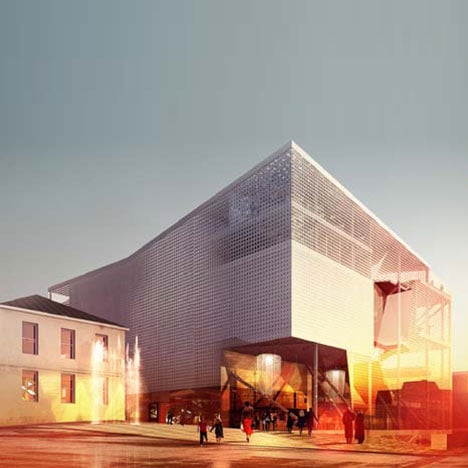
Opera and Cultural Centre by Brisac Gonzalez and Space Group
London firm Brisac Gonzalez in collaboration with Oslo studio Space Group, have won joint first place in a competition to design an opera and cultural centre in Kristiansund, Norway.
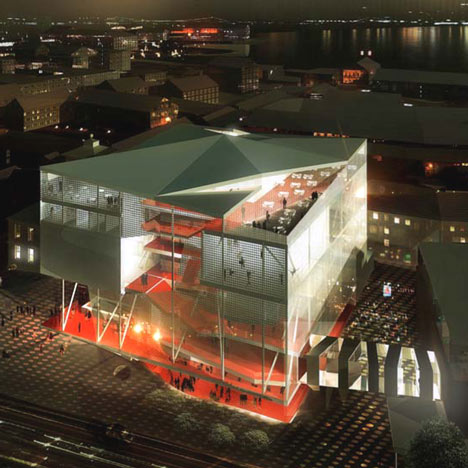
The building's permeated façade will provide glimpses of the interior spaces and the auditorium will feature undulating walls.
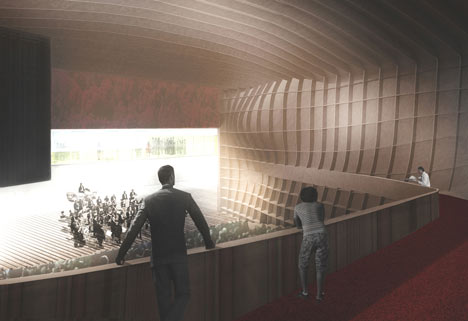
Two existing buildings sit on the proposed site and will be fully refurbished and incorporated into the new proposal.
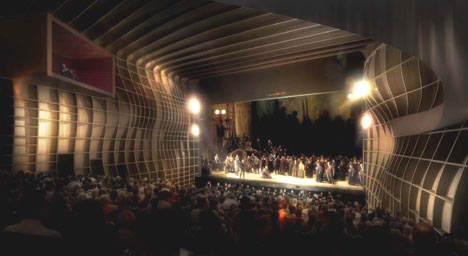
A ribbon-like glazed walkway, which will also serve as an exhibition gallery, will connect the existing building on one side to the main foyer of the new building.
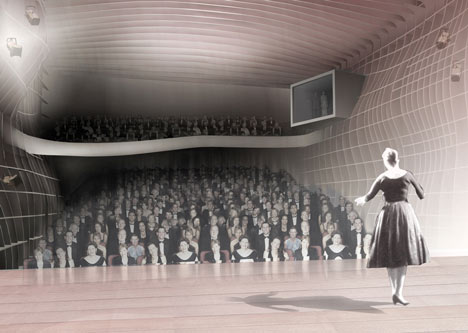
The building will house a 600 seat auditorium, library, education centre, symphony rehearsals, ballet centre, youth centre and restaurants.
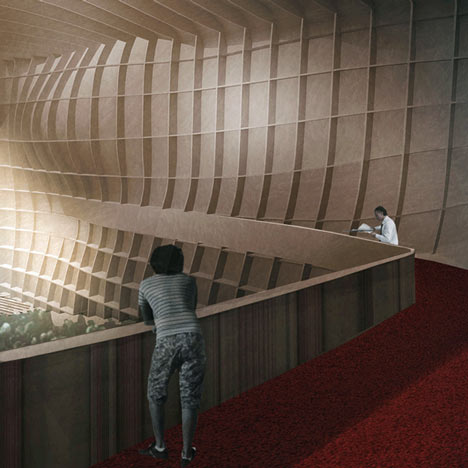
This proposal is a joint winner along with one by C. F. Møller Architects.
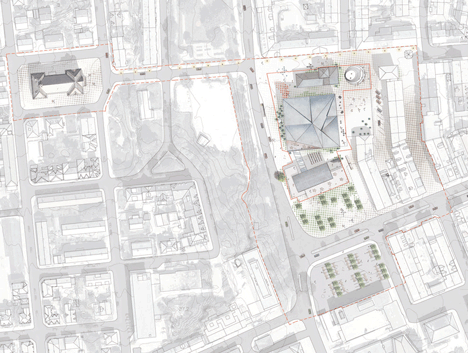
Click for larger image
Here's some more information from the architects:
SPACE GROUP AND BRISAC GONZALEZ WIN COMPETITION FOR CULTURE AND OPERA HOUSE IN NORWAY.
A consortium comprising Oslo based Space Group and Brisac Gonzalez has won joint first winner in a shortlisted competition for the design of the new opera and culture in Kristiansund, Norway. The 1500 m2 project consist a 600 seat auditorium, library, symphony rehearsals, ballet centre, restaurants, youth centre and education centre.
From a long list of thirty seven, five teams were shortlisted for the competition including Snøhetta and Gert Wingårdh.
The architects' team include structural engineer - Adams Kara Taylor, civil engineer - Norconsult, environmental engineer - Atelier 10, theatre constant - Ducks Sceno, acoustics - Sund & Thomassen.
The New Opera and culture house amalgamates opera, library, school, cultural facilities, and youth center. The complex represents culture in its most pervasive and innovative form. To create spaces for the unexpected, spaces to inspire us, spaces where the collective and individual can coexist, to inspire experimentation, invention, heterogeneity and freedom is to liberate culture.
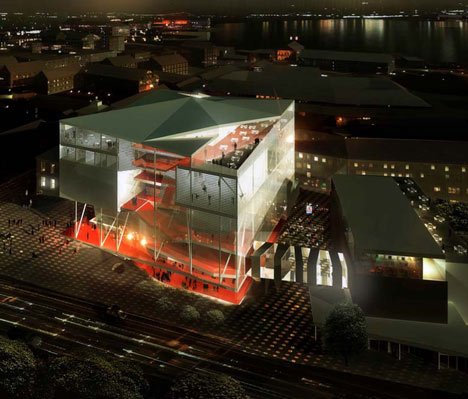
SITE
There are already two significant buildings on the site – a 19th century school building and an early 20th century Folkets Hus (People’s House). To engulf them by a third larger building would diminish their integrity. The design strategy creates a porous cultural compound of three very different free standing buildings that are autonomous yet connected. The two existing buildings will be fully refurbished and filled with a host of new activities. A ribbon-like glass bridge that doubles as exhibition gallery connects the library in the Folkets Hus to the main foyer of the new building. The school building will contain youth cultural activities. An underground passage will link it to the stage level of the new auditorium.
RED CARPET
Inside the new building the public circulation route serves as collective space open for an array of speculative activities. A procession of movement from entry to restaurant, via the red carpeted circuit that weaves it way through the building, reveals at once both the rich interior setting and views of Kristiansund.
THE HALL
The objective for the auditorium is simple: allow for the greatest number of guests to be as close as possible to the stage. From the stage, the performers will see an ocean of people, wall-to-wall. The multi-purpose hall, driven by the demand for flexibility, is often the victim to the paradoxes of big- small, invisible-exposed, functional-beautiful. The design of this hall is one were flexibility exists without succumbing to the generic.
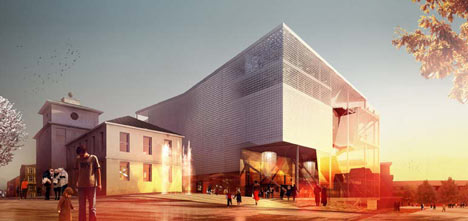
ROOM WITH A VIEW
On the top floor of the new building restaurant, canteen and orchestra rehearsal room can be combined to create a very large room with spectacular views. An expansive exterior terrace adds greater flexibility in a setting where different scenarios, be they planned, impromptu, or incidental can occur.
FACADE
The façade of the new building is curtain-like, selectively revealing the activities within. From the exterior, the perception is of a soft dress, covered in small reflective sequins, shimmering, constantly changing, and flowing. From the inside, the lighting varies from translucent to transparent, providing an even light throughout the building.
Edgar Gonzalez, of Brisac Gonzalez, said: ‘It is an extremely interesting project not only from the wide range of activities in new and existing structures, but from the nature of a very unique collaboration with our Norwegian colleagues. I look forward to be working on another Scandinavian project. We have already built in Sweden. At present we are also working on a feasibility study for the Museum of Copenhagen in the historic centre of the Danish capital.’
Space Group partner Gary Bates, said: ‘We are delighted to have won, and look forward to realizing our dreams for this project.'
The merger of activities in the Kristiansund Opera and culture house represents culture at its most radical and innovative.
Brisac Gonzalez
Brisac Gonzalez is an award-winning international architectural practice based in London. Recent and current projects include: a sports hall that is under construction in central Paris, an 11,000m2 music school and performance hall in the south of France. In Scandinavia, the practice is working on a feasibility study for the Museum of Copenhagen for its new premises within the 8 000m2 historically significant Christian IV that dates back to 1608. Brisac Gonzalez has recently been shortlisted for a mixed-use facility including 100 housing units in the 11th arrondissement of Paris.
Space Group
Space Group (Established 1999, Oslo), is an award-winning network-based architectural and design office - with a broad international expertise that confronts all projects whether large and small projects with the same ambition: to be strategic and innovative, flexible and direct.
Kristiansund
The city of 23,000 inhabitants is built on 5 linked islands and has the same density as the Norwegian capital Oslo. It is probably best known for having Norway’s oldest opera house, an Art Nouveau-style building that was finished in 1914. Historically, Kristiansund has been the most important Norwegian city in the dried -cod trade. Due to the city's heavy involvement in fish processing and international shipping, there used to be as many as seven consulates in Kristiansund, mainly from Latin countries. Kristiansund today is Norway’s second most important oil and natural gas city.
Team
Architects: Space Group - Gary Bates, Gro Bonesmo, Adam Kurdahl Wenche Andreassen, Gesine Gummi, Ingjerd Sandven Kleivan, Naofumi Namba, Jens Noach, Erich Gerlach, Sassi Heiskanen, Tudor Vlasceanu, Jens Niehues, Rebekah Schaberg
Brisac Gonzalez - Edgar Gonzalez, Cécile Brisac, João Baptista Eleftherios Ambatzis, Husain Jaorawala, Miguel Goncalves, Gordon Swapp, Franck Lebouc-Mazé
Structural Engineer: Adams Kara Taylor - Albert Taylor, Paul Scott, Rob Partridge, Clemens Neugart
Services / Environmental: Atelier 10 - Rudolf Duncan-Bosu
Acoustics: Norconsult as / Akustikon - Enno Swets, Jan-Inge Gustafsson
Theatre Consultant: Ducks Sceno - Michel Cova, Frans Swarte, Alina Delgadillo, Analyse Duperrier
Landscape architect: Sundt & Thomassen AS - Trygve Sundt, Marianne Thomassen, Knut Andreas Øyvang
Logistics: Atkins
Visualisations: Luxigon - Eric de Broche des Combes, Laurent Ménabe
See also:
.
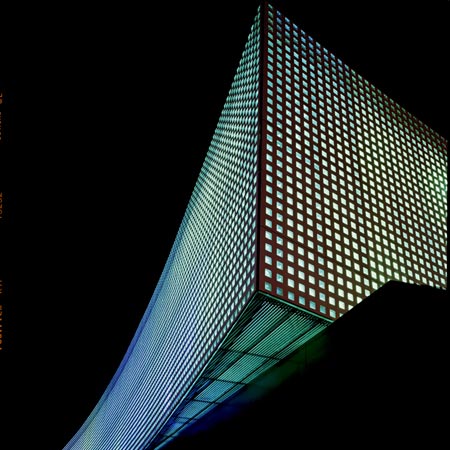 |
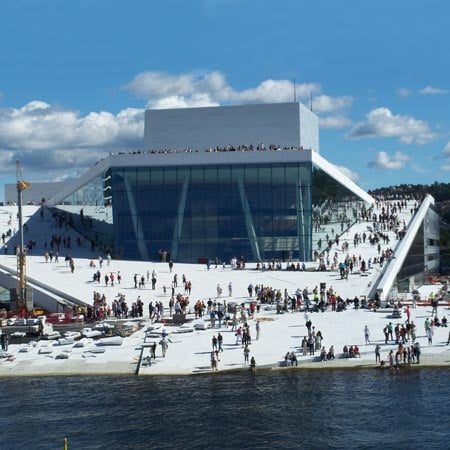 |
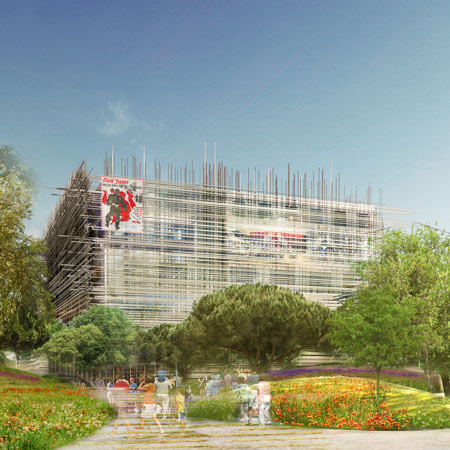 |
| Aurillac concert venue by Brisac Gonzalez |
Opera House Oslo by Snøhetta |
More architecture stories on Dezeen |